How and with what to clean a washing machine: the best methods + review of special products
Do you want to extend the trouble-free operation of your washing machine by cleaning its main elements? Agree, it’s great when the washing machine works like a clock: load the laundry, pour in the powder, press start. To do this, it is worth remembering the most important thing: any equipment needs care.
But the range of detergents is very rich and you don’t know which of them can cope with the task? We will help you figure out how and how to clean your washing machine from a variety of contaminants - from scale to banal dirt and the ubiquitous fungus.
The article discusses effective methods of cleaning the heating element with an overview of the most effective means. To avoid breakdowns of expensive appliances, floods and other consequences of oversight, we offer step-by-step instructions on how to perform comprehensive cleaning of all important components and elements of the washing machine.
We have selected photos depicting important stages of the process, as well as useful videos demonstrating the prevention and maintenance of the unit on our own.
The content of the article:
Why should you clean your washing machine?
Although the purpose of the machine is to “give” us clean things, the condition of the device itself may be far from sterile.
Dirt removed from clothing during washing accumulates on the internal elements.On the sealing rubber and the edges of the drum it is often possible to replace black mold spots, because warmth and moisture are ideal conditions for the development of fungal organisms.
And the heating element and other parts are gradually covered with a coating of salts that are in the water.
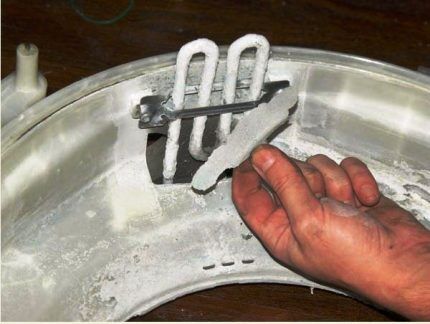
Main sources of pollution:
- high mineralization of water;
- use of aggressive chemicals and low-quality detergents;
- improper operation of the device;
- washing heavily soiled items - overalls with residues of mortar or machine oil, clothes after gardening work, etc.
So, in order to bring your assistant into a perfectly clean appearance, it’s time to do some general cleaning, starting from the body itself and ending with the internal parts.
To wash away obvious external contaminants (stains of gel, conditioner, traces of powder), warm water and a sponge are enough. But you will have to work hard with the parts hidden in the depths of the unit.
We remove scale from the heating element and internal elements
One of the most serious accidents that can easily happen if you do not properly care for your washing machine is the failure of a tubular electric heater.
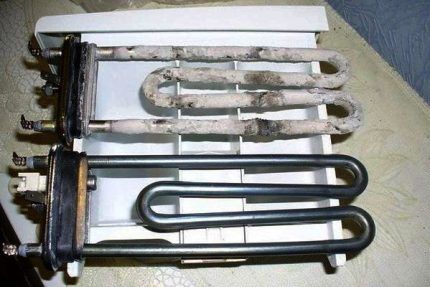
Since the heating element is in contact with running water, scale forms on it after each wash - deposits of calcium and magnesium salts.
Therefore, if a softening filter is not installed in the drain, it is recommended to add special agents to the powder (for example, Calgon) and arrange preventive maintenance at least once a month.
Method #1 - improvised materials from stocks
One of the simplest and most effective ways to combat lime deposits is to pour tribasic carbon or citric acid into the powder compartment and turn on any high temperature mode.
This recipe works simply: when heated, the acid actively corrodes not only light deposits, but also caked limestone, as a result of which it cleans both the heating element and the steel of the drum.
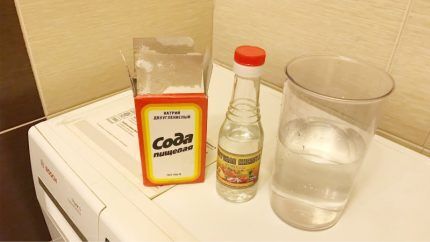
Calculation of the required amount of powder must be done based on the degree of contamination of the machine and its container. On average, for every kilogram of loading there is about 25-30 grams of acid.
If the unit has not been cleaned for a long time, you can take note of the following advice: pour acid into the powder container, run any long washing mode with a temperature of 90°C and above and turn off the power from the network halfway through the process. Leave it overnight and start the machine again in the morning.
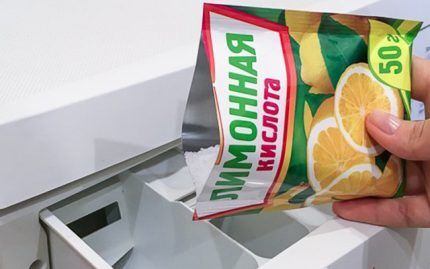
It is recommended to use this procedure no more than 4 times a year, and after each time you must check the drain hose and drum cuff to remove large particles of loose limestone.
Other home remedies and their uses:
- Table vinegar – pour 1-2 cups of a 9 percent acetic acid solution into the detergent cuvette, select a high-temperature mode with long washing and pre-soaking. To get rid of the specific sour smell, you can then turn on an additional rinse.
- Baking Soda and Vinegar – to enhance the effect of acid on limescale, a special solution is useful. It is prepared like this: half a glass of soda is mixed with the same amount of water and placed in a container for powder, and 1 glass of 9% vinegar is poured into the drum. Then the machine starts in any long-term mode at maximum temperature.
- Bleach and other chlorine-containing products – in the old fashioned way, they are used by many housewives for comprehensive cleaning and disinfection of the washing machine.
But in fact, the effectiveness of caustic preparations is very doubtful: they will not save you from scale, but some elements (for example, the rubber drum seal and various sealing gaskets) can cause great damage. And chlorine vapors are harmful to health.

But we looked at the most reliable, cheap, safe and practice-tested methods for getting rid of scale using improvised means.
Method #2 - special chemicals
The cleaning agent for washing machine elements must be safe for humans, fabrics and all internal surfaces of the device, and also effectively remove lime deposits and other contaminants.
Specialized preparations have an important advantage over “folk” ones - their composition is developed taking into account the design features of the device and does not harm some elements while cleaning others.
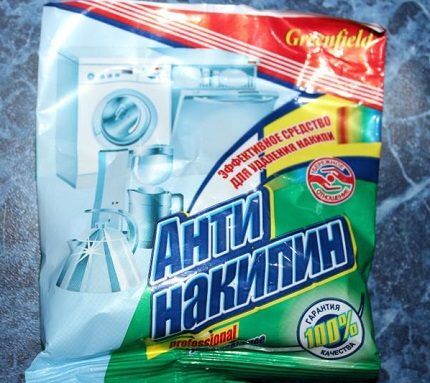
Review popular specialized products:
- Topper 3004 (Germany) – descaling cleaner, suitable for dishwashers and washing machines. It removes scale of varying degrees well, recommended by Bosh manufacturers.
- Schnell Entkalker – powder for quick cleaning of internal elements from stubborn lime deposits. Produced in Germany, available in 200g packs.
- Antikalk for Washing Machines from Sano (Israel) – a universal gel for the prevention and elimination of small plaque with an antibacterial effect.
- Magic Power (Germany) – one of the best specialized products for washing machines. Available in the form of gel and powder, which effectively removes plaque from heating elements, tanks, and drums.
- Beckmann (Germany) - a universal preparation that will protect against scale and get rid of unpleasant odors caused by various contaminants. But, like any multi-purpose product, it is good for regular care, but will be ineffective against heavy dirt.
- Filtero 601 (Germany) – works well to remove old scale from the heater and other elements; it is recommended to use 3-4 times a year for intensive cleaning of the machine. Available in 200 g bags for one use.
- Doctor TEN (Russia) and Antiscale (Belarus) - analogue powder preparations intended only for removing scale, but from any equipment. An inexpensive and convenient solution to the problem of lime deposits on the heating elements of both washing machines and dishwashers.
Please note that many products that, judging by the advertising, are guaranteed to protect our machine from problems with plaque, will not get rid of existing scale, but will simply reduce the concentration of salts in the water, for example, the same Calgon.
It is easy to distinguish between them - it is recommended to add such preparations before starting the machine along with the powder or directly into the drum, and they are used when washing things.
Method #3 - manual cleaning
If you have never thought about how to clean your washing machine and all its key elements before, and the assistant has served you for more than one year, it is recommended that you first carry out a visual inspection of the heating element.
Most likely, a multi-layered limestone has already formed on the heating element, which will be easier to remove manually - with standard cleaning methods, broken-off solid plaque particles may remain inside the unit.
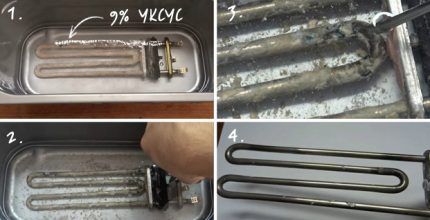
To clean the heating element we proceed in stages:
- Disconnect the wires, sensor and remove the heating element. Scale and dirt can interfere with the process, so after loosening the fastening, carefully pry up the metal flange with a flat-head screwdriver. But be careful and proceed smoothly so as not to damage the tank itself and the wiring.
- We rinse the heating element under good pressure of warm waterto remove loose plaque and dirt.
- Making a concentrated solution to remove stone residues: pour 3-4 tbsp into a plastic bottle with a cut off neck. citric acid powder, place the heating element inside and fill with hot water to the level of the bar.
- Shake the liquid to activate the cleaning process. Rising air bubbles will indicate that magnesium and calcium salts have begun to dissolve.
In this state, we leave the heating element to soak overnight. And in the morning, we rinse the metal under running water with a soft sponge, wipe it dry, admire the glare of light on the sparkling stainless steel and install the element back into the device.

By the way, if you take the machine apart, you can also inspect the condition of the drum. You may have to dismantle it too in order to thoroughly clean all the holes and remove scale and mold.
But you shouldn’t do this without extreme necessity and skills in working with equipment; you can get by with treatment with a good special tool.
Procedure for comprehensive cleaning
In addition to scale, there are other problems that can be caused by improper operation of the machine: dirt, unpleasant odor, mold. Therefore, you should regularly maintain the cleanliness of the internal elements.
Step #1 - wash the drum
After each wash, residual water and dirt remain in the drum. And soon black spots appear in the folds of the sealing cuff, and a musty smell comes from the depths of the machine.
Starting at idle speed with the addition of disinfectants or regular citric acid will help solve the odor issue. But the gum needs to be thoroughly cleaned by hand.
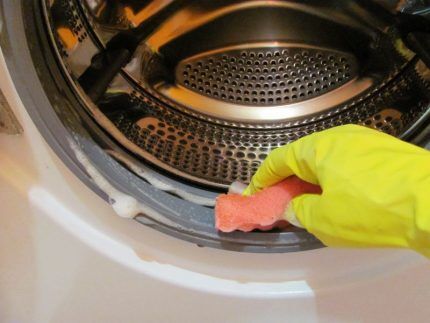
The easiest option is to carefully push the folds apart, wash the cuff around the circumference with a sponge, soap and warm water, and then wipe dry.
If you notice mold stains, you can use a solution of copper sulfate or prepare a cleaning paste of water and baking soda in equal proportions.
Then thoroughly treat the elastic band and the entire drum with this mixture, leave for a couple of hours, and then wipe with a sponge and start the long-term wash cycle.
For more information on cleaning your washing machine drum, see this article.
Step #2 - clean the filter and drain hose
The cause of an unpleasant odor can also be debris invisible to the eye - hair, particles of soil or building materials, lint, feathers and various small objects that were not removed from clothing pockets in time.
All this accumulates in the filter and hose through which the machine releases waste water. It is recommended to carry out cleaning the drain filter washing machine at least once every 3 months, and with active use, more often.
To do this, you need to remove the protective panel, place a small container for draining water or place a rag on the floor. Then unscrew counterclockwise and remove the filter. Rinse it under high pressure water and remove accumulated debris from the hole.
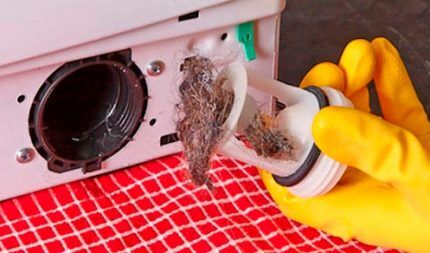
To rinse the hose, you need to drain the remaining water in the machine through the drain filter and then disconnect it from the entrance to the sewer pipe or siphon. After this, you can remove the part, but exactly how to do this depends on the design of the device itself.
For example, in cars Ariston, Samsung, Indesit, LG, Whirlpool, Ardo You can only get to the hose connection through the bottom.
To do this, you need to lay the device on its side, remove the bottom panel and filter, and loosen the clamp with pliers. All that remains is to disconnect the pump and remove the hose itself.
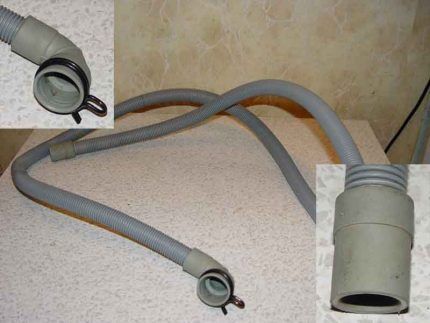
In cars Electrolux And Zanussi you need to look for the drain fastening behind the rear panel, and Bosch and Siemens - behind the front when it comes to front-loading machines.
But for vertical models, you can only get to the hose through the side cover. Therefore, it will not be superfluous to check the instructions, which describe the device diagram.
To clean the drainage hose from dirt and powder deposits, equip yourself with a thin non-metallic cable with a mini brush attached to one end.
We run this brush inside, scroll it and gradually move it to the end of the hose. Then rinse under pressure of warm water. For severe contamination, several passes can be made.
Step #3 - wash the powder container
A rough coating from hard water appears on the walls of the detergent compartment, and traces of powder and various rinse aids remain.All this needs to be removed.
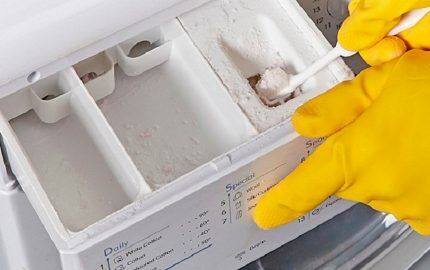
We act in stages:
- We remove the cuvette from the compartment and remove the container for the conditioner.
- We rinse under running water, wipe off mold stains with soda or any chlorine-containing product (there are no rubber elements here, so chlorine will not harm).
- Pour a packet of citric acid into a small bowl.
- Place the disassembled cuvette, fill it with hot water and leave for an hour (if it is heavily soiled, it can be overnight).
- Then we remove the remaining plaque with a sponge and thoroughly clean all joints with a toothbrush.
- Dry the container, assemble and place in place.
Another option for dealing with plaque is to fill the removed cuvette with soda and add table vinegar. As a result of the reaction, the soda will foam and soften the lime deposits so that they are easier to remove.
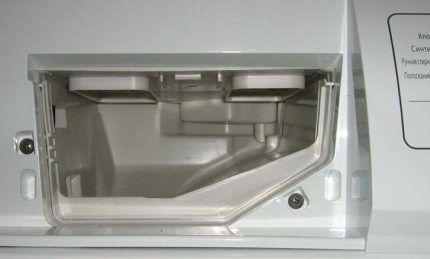
To get rid of dirt and plaque in the container compartment, you can use the same soda paste and toothbrush, and pre-treating the tray with a spray cleaner will help speed up the process.
Rules for caring for your washing machine
If you regularly take care of your assistant, you can do without disassembling the structure and unscheduled replacement of its elements. And to do this you just need to follow a few simple rules.
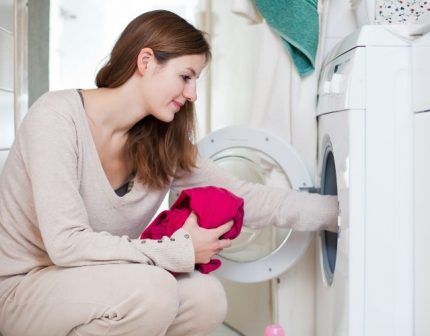
Recommendations and useful tips for care:
- After washing, always wipe the door glass, drum and rubber band dry, and rinse the powder container under good pressure with warm water and dry.
- If you have hard water in your area, you can equip the water supply hose to the machine with a magnetic filter. The flow will pass through a magnetic field and change the crystalline structure of the water, as a result of which scale simply does not form.
- Wash blankets, sweaters and other fleecy items in a special fine-mesh bag.
- Do not leave wet clothes in the washing machine even for a couple of hours - in addition to the unpleasant smell, the consequences of such forgetfulness will soon appear as black mold spots.
- Promptly remove powder stains, water drips and grease splashes (applies to appliances installed in the kitchen) from the appliance body.
Depending on the time the stain appears, the options for getting rid of it will differ. To remove fresh dirt, simply wipe the plastic with a cloth soaked in water or a solution of dishwashing liquid. And baking soda paste will help deal with old yellow spots and stains.
The frequency of preventive cleaning with home or professional products depends on the quality of the water in your system, the use of softeners and how often you use the washing machine.
On average, the procedure for disinfestation and descaling should be carried out once every 2-3 months. And do not forget to rinse the filter and drum cuff to remove lime particles after all cleaning compounds.
Conclusions and useful video on the topic
Dirt and scale threaten not only the breakdown of the device. They cause problems that are initially unnoticeable, for example, they increase the operating time of the machine, the consumption of electricity and detergents.
To prevent this from happening, we suggest studying the visual instructions for caring for the machine.
Recommendations for comprehensive cleaning of washing units:
How to remove heavy scale from the surface of a heating element:
Clean the powder container using baking soda and vinegar:
How to remove and wash the filter from dirt and other debris accumulations:
Caring for the washing machine is quite simple. However, if you neglect the operating recommendations, your assistant may soon need professional “reanimation”, replacement of the heating element and other elements. To prevent this from happening, carry out timely prevention on your own or entrust it to specialists.
Do you have anything to add or have questions about cleaning and maintaining your washing machine? You can leave comments on the publication, participate in discussions and share your own experience of caring for a home assistant. The contact form is located in the lower block.




I’m ashamed to admit, but I haven’t cleaned the rubber seal for a long time. And when I once again threw the laundry into the washing machine, after washing it became even dirtier. I noticed pieces of dust stuck to all my things. When I started to figure out what the reason was, the first thing I decided to do was look under the seal and was horrified. What was there? Now after every wash I put the seal in order.
Nowadays there are many effective chemical tablets: you throw them into a drum and you're done. But you can always try to clean it yourself, using the means at hand, without leaving home to the market to buy a product, although it does not always help. From personal experience I can say that the most effective way is to use ordinary vinegar.You pour two glasses into the powder compartment and run it for the longest wash cycle. I checked it on my machine, after that it shines like new.
Thank you for the article. My washing machine recently broke down, although I didn’t fix it myself; I contacted a service center in Moscow. To monitor the work of craftsmen, it is also very useful to understand the causes and methods of eliminating breakdowns.
Well, I don’t know, some people are clever with citric acid and other things, I wouldn’t do that... after all, there are a lot of special products. I don’t have the most expensive indezite, but even then I wouldn’t want to clean it, I don’t know how to clean it, you never know... it’s better to be safe than sorry.
In my opinion, as for the heating element, it’s easier to simply replace it with a new one once every year or two than to buy all these calgons. It will be cheaper. The average heating element costs around 1000 rubles. Not such a big amount. It’s even better to install a pre-filter, then you will have to change it even less often.
Thanks a lot! I was removing scale from the heating element of my Schnell Entkalker indesit. I do this to maintain order, so to speak. But there have been no problems for 6 years now and nothing has broken.
But what about the statement:
“Under no circumstances should you use citric acid. This is due to the fact that the drum cross of all modern machines, which serves to secure it, is made of silumin, which is destroyed upon contact with pure citric acid" (https://ichip.ru/sovety/ekspluataciya/kak-pravilno-ekspluatirovat-stiralnye-mashiny-sovety-ot-proizvoditelya-744032?utm_referrer=https%3A%2F%2Fzen.yandex.com)
Disc cleaners
Well, no, it’s better to call if you already need to clean the washing machine, it’s not as easy as it seems.I decided for myself that I would use Calgon gel to keep the machine clean and use laundry detergent more economically. So far everything is fine, I see the effect.